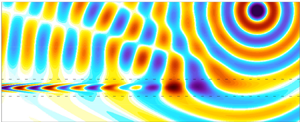Crossref Citations
This article has been cited by the following publications. This list is generated based on data provided by
Crossref.
Spieser, Étienne
Legendre, César
and
Bailly, Christophe
2021.
Solution of Pierce’s equation for Tam & Auriault's mixing noise model.
Le Bras, Sophie
Gabard, Gwénaël
and
Bériot, Hadrien
2022.
Direct and adjoint problems for sound propagation in non-uniform flows with lined and vibrating surfaces.
Journal of Fluid Mechanics,
Vol. 953,
Issue. ,
Gryazev, Vasily
Markesteijn, Annabel P.
and
Karabasov, Sergey A.
2022.
Generalized Acoustic Analogy Modeling of Hot Jet Noise.
AIAA Journal,
Vol. 60,
Issue. 4,
p.
2383.
Nagy, Attila Balázs
Delfs, Jan
and
Bennett, Gareth J.
2022.
Aeroacoustics research in Europe: The CEAS-ASC report on 2020 & 2021 highlights.
Journal of Sound and Vibration,
Vol. 534,
Issue. ,
p.
117002.
Spieser, Étienne
Legendre, César
and
Bailly, Christophe
2022.
Comprehensive acoustic modelling of the installation effects of a subsonic jet beneath a flat plate.
Kopiev, V. F.
and
Chernyshev, S. A.
2022.
The Separation of Acoustic and Hydrodynamic Variables in the Model of Sound Sources of a Turbulent Jet.
Doklady Physics,
Vol. 67,
Issue. 9,
p.
258.
Schoder, Stefan
Kaltenbacher, Manfred
Spieser, Étienne
Vincent, Hugo
Bogey, Christophe
and
Bailly, Christophe
2022.
Aeroacoustic wave equation based on Pierce's operator applied to the sound generated by a mixing layer.
Schoder, Stefan
Spieser, Étienne
Vincent, Hugo
Bogey, Christophe
and
Bailly, Christophe
2023.
Acoustic Modeling Using the Aeroacoustic Wave Equation Based on Pierce’s Operator.
AIAA Journal,
Vol. 61,
Issue. 9,
p.
4008.
Spieser, Étienne
Bogey, Christophe
and
Bailly, Christophe
2023.
Noise predictions of a Mach 0.9 round jet using tailored adjoint Green’s functions.
Journal of Sound and Vibration,
Vol. 548,
Issue. ,
p.
117532.
Brouzet, Davy
Krisna, Benyamin
McCormick, Duane
Reimann, C. Aaron
Mendoza, Jeff
and
Ihme, Matthias
2024.
Analysis of direct and indirect noise in a next-generation aviation gas turbine combustor.
Combustion and Flame,
Vol. 260,
Issue. ,
p.
113249.
Foglia, Enrico
Daroukh, Majd
Buszyk, Martin
Salah El-Din, Itham
and
Moreau, Stephane
2024.
Towards the Optimization of Propeller Tonal Noise in the Frequency Domain Using the Discrete Adjoint Method.
Schoder, Stefan
Bagheri, Eman
and
Spieser, Étienne
2024.
Aeroacoustic Source Potential Based on Poisson’s Equation.
AIAA Journal,
Vol. 62,
Issue. 7,
p.
2772.
Marchner, P.
Bériot, H.
Le Bras, S.
Antoine, X.
and
Geuzaine, C.
2025.
A Domain Decomposition Solver for Large Scale Time-Harmonic Flow Acoustics Problems.
SIAM Journal on Scientific Computing,
Vol. 47,
Issue. 2,
p.
B333.
Bailly, Christophe
Durox, Daniel
Juniper, Matthew
Noiray, Nicolas
Poinsot, Thierry
Schuller, Thierry
and
Veynante, Denis
2025.
A dedicated paper for Pr Sébastien Candel EM2C laboratory, CentraleSupélec.
Combustion and Flame,
Vol. 279,
Issue. ,
p.
114301.


